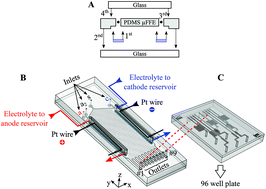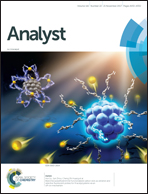Integration of polycarbonate membranes in microfluidic free-flow electrophoresis†
Abstract
A general difficulty in the miniaturization of free-flow electrophoresis relates to the need to separate electrodes and separation bed compartments. This is usually performed by using membranes, which are either difficult to fabricate and integrate into microfluidic channels, or not stable over time. Here, we propose the use of track-etched polycarbonate membranes. Fabrication of the miniaturized device and integration of the membrane was simple, reproducible and allows for long shelf times. Furthermore, the membranes were resistant to high pressure values (up to 105 Pa), and contributed negligible electrical resistance, allowing setting of electric fields at the separation bed with high efficiency. A second microfluidic device was connected to the microfluidic free-flow electrophoresis chip via tubing, ensured flow stability over time and was used as a chip-to-world interface to a 96 well plate. We demonstrated microfluidic free-flow zone- and field-stacking electrophoresis, and isoelectric focusing proof-of-principle experiments, using fluorescent analytes and monitoring via fluorescence microscopy. Furthermore, the separation of a mixture of 7 proteins was performed in microfluidic free-flow zone electrophoresis mode. Subsequent analysis via protein mass spectrometry of the collected fractions revealed separation of the protein mixture, indicating a wide range of applications in the characterization of proteins and biosimilars.



 Please wait while we load your content...
Please wait while we load your content...